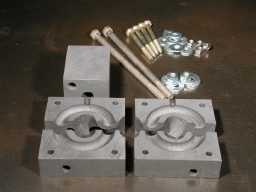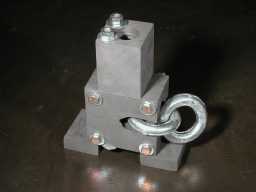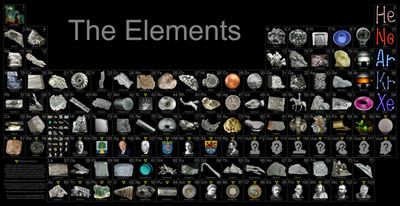|
|
|
|
|
|
|
|
|
|
|
|
|
|
|
|
Cadmium used to be used extensively as a protective coating for steel, in much the way that zinc is used today ("Galvanized" steel is zinc-plated). Cadmium plating is still used in some specialized applications, but the toxicity of cadmium has discouraged more common use as a plating.
Large amounts of cadmium are used in Nickel-Cadmium (Ni-Cad) rechargeable batteries, used in a wide variety of electronic devices. Again the toxicity of cadmium is a problem, and it's important to bring rechargeable batteries back for recycling, to avoid contaminating landfills. Fortunately Ni-Cad technology is being replaced in many applications by nickel-metal-hydride and lithium-ion technologies, which are both longer-lasting and less toxic.
|
|
| |
|
|
|
|
|
 2 inch anode ball. 2 inch anode ball.
Purchased from eBay seller "El_Three" in May 2002. Similar balls are for sale in 100lb quantities by suppliers who list them as "anode balls". I'm not clear what industrial process they are used for, but reader Dan Burrill from the UK reports as follows:It is almost certainly used in electroplating, where the anode often consists of a cloth bag containing balls of metal or shot, depending upon the exact coating required. I'm not an expert on the subject, but my late father and I have worked in plating factories in the past and seen this in action. I believe this is done to provide a larger surface area, whilst the cloth bag prevents particles of the disintegrating anode from detaching and adhering to the article being plated.
From memory, nickel-cadmium plating used to be used on engine parts and other high-wear, high-temperature items, but I know this was banned in the UK some time ago (I'm not sure about its current status in other parts of the world). I believe it was replaced with zinc-nickel, but couldn't say for sure. Sounds plausible to me.
Source: eBay seller el_three
Contributor: Theodore Gray
Acquired: 13 May, 2002
Price: $35
Size: 2"
Purity: >95%
|
|
|
|
|
|
|
Small lump 99.998%.
Kindly donated by David Franco, who sent many elements after seeing the slashdot discussion.
Source: David Franco
Contributor: David Franco
Acquired: 17 May, 2002
Price: Donated
Size: 0.2"
Purity: 99.998%
|
|
|
|
|
|
|
Sample from the RGB Set.
The Red Green and Blue company in England sells a very nice element collection in several versions. Max Whitby, the director of the company, very kindly donated a complete set to the periodic table table.
To learn more about the set you can visit my page about element collecting for a general description or the company's website which includes many photographs and pricing details. I have two photographs of each sample from the set: One taken by me and one from the company. You can see photographs of all the samples displayed in a periodic table format: my pictures or their pictures. Or you can see both side-by-side with bigger pictures in numerical order.
The picture on the left was taken by me. Here is the company's version (there is some variation between sets, so the pictures sometimes show different variations of the samples):

Source: Max Whitby of RGB
Contributor: Max Whitby of RGB
Acquired: 25 January, 2003
Text Updated: 11 August, 2007
Price: Donated
Size: 0.2"
Purity: 99.9975%
|
|
|
|
|
|
|
Sample from the Everest Set.
Up until the early 1990's a company in Russia sold a periodic table collection with element samples. At some point their American distributor sold off the remaining stock to a man who is now selling them on eBay. The samples (except gases) weigh about 0.25 grams each, and the whole set comes in a very nice wooden box with a printed periodic table in the lid.
To learn more about the set you can visit my page about element collecting for a general description and information about how to buy one, or you can see photographs of all the samples from the set displayed on my website in a periodic table layout or with bigger pictures in numerical order.
Source: Rob Accurso
Contributor: Rob Accurso
Acquired: 7 February, 2003
Text Updated: 29 January, 2009
Price: Donated
Size: 0.2"
Purity: >99%
|
|
|
|
|
|
|
Anode balls.
These balls are identical to my first sample under cadmium, the difference is that when I got the first sample, the thought of purchasing a hundred pounds of cadmium was ludicrous. These balls are part of a lot of a hundred pounds (91.5 actually) I purchased from a large cadmium distributor recently. How things change.... Most of the balls are stock for future museum displays being developed by Max Whitby and myself, but I've extracted a tax of a few for my table and for my multi-metal chain (see below).
Source: sulfuric.com
Contributor: Theodore Gray
Acquired: 1 August, 2003
Text Updated: 11 August, 2007
Price: $1.70/pound
Size: 2"
Purity: 99.98%
|
|
|
|
|
|
|
Link in multi-metal chain.
I had been wondering about how hard it would be to make a multi-part graphite mold with which I could cast chain links around each other. That is, given an existing link, cast a new one interlinked with it. This turns out to be quite do-able: Here is the mold I made (using my drill press as a vertical mill and a round-ended router bit):
 
In case you ever want to try this, I'll give you an important hint: The third link is the real test, not the second one.
Using this mold I have cast a chain out of all the metals I can easily cast. Click the Sample Group link below to see all the links together.
This chain (counted as one sample) is the 600th sample added to my collection.
Source: sulfuric.com
Contributor: Theodore Gray
Acquired: 9 August, 2003
Text Updated: 20 February, 2006
Price: $1/pound
Size: 3"
Purity: 99.99%
Sample Group: Multi-metal Chain
|
|
|
|
|
|
|
|
|
|
Museum-grade sample.
In early 2004 Max Whitby and I started selling individual element samples identical or similar to the samples we use in the museum displays we build. These are top-quality samples presented in attractive forms appropriate to the particular element. They are for sale from Max's website and also on eBay where you will find an ever-changing selection of samples (click the link to see the current listings).
This ingot is designed to show what the surface of the metal looks like when hammered: By comparing with similar hammered ingots of other metals an idea of the hardness and working characteristics of the metal is given. (We use approximately the same hammering force on each ingot, so lead will show much deeper hammer marks than zinc, for example.)
Source: Theodore Gray
Contributor: Theodore Gray
Acquired: 6 March, 2004
Text Updated: 11 August, 2007
Price: See Listing
Size: 4"
Purity: >99%
Sample Group: RGB Samples
|
|
|
|
|
|
|
 Museum-grade sample. Museum-grade sample.
In early 2004 Max Whitby and I started selling individual element samples identical or similar to the samples we use in the museum displays we build. These are top-quality samples presented in attractive forms appropriate to the particular element. They are for sale from Max's website and also on eBay where you will find an ever-changing selection of samples (click the link to see the current listings).
This cast ball is designed to show what the surface of the metal looks like when hammered: By comparing with similar hammered balls of other metals an idea of the hardness and working characteristics of the metal is given. (We use approximately the same hammering force on each ball, so lead will show much deeper hammer marks than zinc, for example.)
Source: Theodore Gray
Contributor: Theodore Gray
Acquired: 1 May, 2004
Text Updated: 11 August, 2007
Price: See Listing
Size: 2"
Purity: >99%
Sample Group: RGB Samples
|
|
|
|
|
|
|
  High purity cadmium. High purity cadmium.
When you reach the rarefied levels of purity represented by four or five nines, many metals become smooth, shiny, and crystalline. Generally speaking, the higher the purity, the bigger the crystals (cooling rate also effects crystal size, but as a general rule without high purity you can't get big crystals). This bar was hand made by Heinrich Pniok, owner of probably the finest collection of very high purity elements, and now a supplier to the element hobby. The large crystal facets are very unusual for cadmium, which is normally a dull, grayish metal in is common low-purity form.
Source: Heinrich Pniok
Contributor: Theodore Gray
Acquired: 31 July, 2004
Text Updated: 11 August, 2007
Price: $70
Size: 1.5"
Purity: 99.999%
|
|
|
|
|
|
|
  Fish. Fish.
I cast this fish for the purpose of making a high-resolution 360 rotation image of it (click turntable icon or Spin link to see it). The yellow film covering some of the scales is either a thin layer of cadmium oxide, or possibly cadmium sulfide formed because I have used the same mold to cast sulfur fish before. Cadmium yellow (cadmium sulfide) is a classic painter's pigment so I hope that's what it is. Though toxic, it was widely used, and accounts for some of the bright, vibrant color in paintings of the impressionist period (Monet and all that). The fish shape comes from a cast iron corn bread mold, whose non-stick Teflon coating seems to have no problem with zinc, tin, cadmium, and similar metals with reasonably low melting points.
I chose this sample to represent its element in my Photographic Periodic Table Poster. The sample photograph includes text exactly as it appears in the poster, which you are encouraged to buy a copy of.

Source: sulfuric.com
Contributor: Theodore Gray
Acquired: 11 September, 2005
Text Updated: 16 March, 2009
Price: $1/pound
Size: 3"
Purity: 99.99%
|
|
|
|
|
|
|
  Element coin. Element coin.
Dave Hamric sells element samples under the name Metallium. He's developed a line of coins struck out of various common and uncommon metals: They are quite lovely, and very reasonably priced, considering the difficulty of creating some of them.
Here is the back side of this coin (click either picture to see it larger):

Click the Sample Group link below to see many other coins made of various elements, or click the link to his website above if you want to buy one like this.
Source: Dave Hamric
Contributor: Theodore Gray
Acquired: 1 December, 2006
Text Updated: 14 January, 2007
Price: $14
Size: 0.75"
Purity: >99%
Sample Group: Coins
|
|
|
|
|
|
|
  Rod. Rod.
This is a rod of cadmium, but I'm not sure where it came from, so I can't say much about it. Cadmium is often sold in smallish rods and bars, I think because one of its main applications is in plating, where it needs to be melted down or dissolved.
Source: Unknown
Contributor: Unknown
Acquired: 20 January, 2007
Text Updated: 21 January, 2007
Price: Unknown
Size: 4"
Purity: 99%
|
|
|
|
|
|
|
  Sublimed cadmium. Sublimed cadmium.
This sample could also be called vacuum distilled cadmium. Sublimation means going directly from a solid to a vapor state, like boiling without going through the liquid state in between. Distillation means the process of evaporating (usually by boiling) a substance and then catching the vapor on a cold surface, where it re-condenses into liquid or solid form. The purpose is usually purification.
For example, alcohol boils at a lower temperature than water, so if you have a fermented mixture of water, yeast, and alcohol, you can separate out the alcohol by heating the liquid to the point where the alcohol evaporates, but the water mostly says put. The alcohol vapor can then be condensed on a cold plate or pipe, and collected in a separate flask.
It's somewhat surprising at first to think that the same thing can be done with metal, but really it's just a question of higher temperatures. Any metal will eventually turn into a gas if you make it hot enough, and that means any metal can be distilled. When the collection plate is cold enough that the metal condenses directly into a solid the result is often beautiful vapor-deposited crystals, as you see in this sample.
Ivan has kindly provided these pictures of the sublimation apparatus he used to create this sample: Picture 1, Picture 2, Picture 3. He reports the cadmium was heated to 250-260 C and the pressure during sublimation was 0.0005-0.0001 mm Hg. The yellow in the bottom of the bulb is cadmium oxide on the surface of the starting material, and you can see the final product collected on the top inside surface of the bulb.
Source: Ivan Timokhin
Contributor: Ivan Timokhin
Acquired: 28 December, 2006
Text Updated: 11 February, 2007
Price: Donated
Size: 3"
Purity: >99.99%
|
|
|
|
|
|
|
  Cadmium shielding foil. Cadmium shielding foil.
This is fairly thin cadmium foil said to come from a nuclear research facility and intended for use as radiation shielding. Lead is much more common as a shielding material, but cadmium works better for neutrons, which tells you this came from a serious place, as neutrons are not something you get from common radioactive minerals and the like.
Source: Anonymous
Contributor: Anonymous
Acquired: 24 December, 2007
Text Updated: 8 March, 2008
Price: Donated
Size: 5"
Purity: 99%
|
|
|
|
|
|
|
  Cadmium and dichromate plated castle nuts. Cadmium and dichromate plated castle nuts.
These large (3/4") castle nuts are plated first with cadmium and then treated with acidified dichromate salt solutions to convert the surface layer of cadmium metal into insoluble cadmium chromate, which doesn't corrode and produce toxic cadmium oxide dust.
Source: eBay seller seismoman
Contributor: Theodore Gray
Acquired: 28 February, 2009
Text Updated: 16 April, 2009
Price: $1
Size: 1"
Purity: <1%
|
|
|
|
|
|
|
  Cadmium and dichromate plated thumb screws. Cadmium and dichromate plated thumb screws.
These thumbscrews are plated first with cadmium and then treated with acidified dichromate salt solutions to convert the surface layer of cadmium metal into insoluble cadmium chromate, which doesn't corrode and produce toxic cadmium oxide dust.
Source: eBay seller seismoman
Contributor: Theodore Gray
Acquired: 28 February, 2009
Text Updated: 16 April, 2009
Price: $1
Size: 1"
Purity: <1%
|
|
|
|
|
|
|
|
|
|
|
|
|
|
|
|
  Cadmium sulfide photoresistor. Cadmium sulfide photoresistor.
The s-curve on this sensor is made of cadmium sulfide, a semiconductor that becomes significantly more conductive to electricity when it is exposed to light. The sensor is wired in series with a wire coil wrapped around a bi-metallic strip. In the dark, little current flows through the circuit, and the wire coil remains cold. When exposed to light, the resistance drops, current flow increases, and the wire coil heats up the bi-metallic strip, causing it to bend, which in turn snaps a relay contact to the opposite position. This is a daylight sensor designed to turn an outdoor lamp on at dusk and off at dawn.
Source: Farm & Fleet
Contributor: Theodore Gray
Acquired: 22 April, 2009
Text Updated: 23 April, 2009
Price: $10
Size: 0.5"
Purity: <30%
|
|
|
|
|
|
|
|
|
|
|
|
|
|
|
|
  Ni-Cad battery. Ni-Cad battery.
A common nickel-cadmium battery. These have fallen out of favor due to the toxied nature of cadmium. Nickel metal hydride and lithium ion batteries are pretty much better in all ways..
Source: eBay
Contributor: Theodore Gray
Acquired: 11 March, 2009
Text Updated: 12 March, 2009
Price: $5
Size: 2"
Composition: NiCdMn
|
|
|
|
|
|
|
|
|
|
|
|